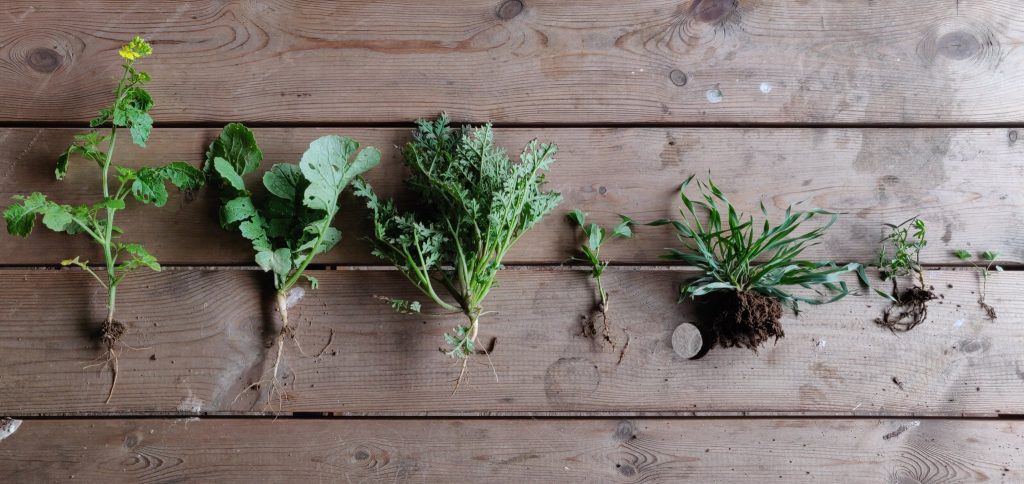
What we’re learning about cover crops
This is a longer read than usual, a follow-on from our post about fixing our soils.
As heavy rain fell last February after an already wet January, our soil had no more capacity to hold water, and it ran off the fields in growing rivulets, carving channels up to three feet deep and carrying soil away with it by the tonne.
Norfolk Rivers Internal Drainage Board (IDB) helped us with urgent work to mitigate against the worst of the runoff and erosion on one of our fields, including adding ditches and a pond to capture runoff.
With the urgent works done, we then spoke with the Water Sensitive Farming Team at Norfolk Rivers Trust about our longer-term aim to manage water on the farm. The team saw the issues we had with our soils and listened to our concerns. It became obvious that our flooding and erosion issues were caused at least as much by the state of our soils as they were by sloping fields and heavy rainfall.
We discussed some of the things we could do:
- Add hedging plants to stabilise the banks of new ditches in one field where we had seen the worst runoff
- Add trees to the bottom of the same field to stabilise the soil and reduce flood risk
- Add a hectare of pollen and nectar mix to the bottom of another field to reduce flood and erosion risk by providing continuous green cover
- Remove high-risk crops (root veg) from the rotation
- Add cover crops to fields left bare after carrots were harvested in March, as well as to a field of wheat stubble.
Using cover crops, in particular, was exciting – and new for the farm. But where to start?
What are cover crops?
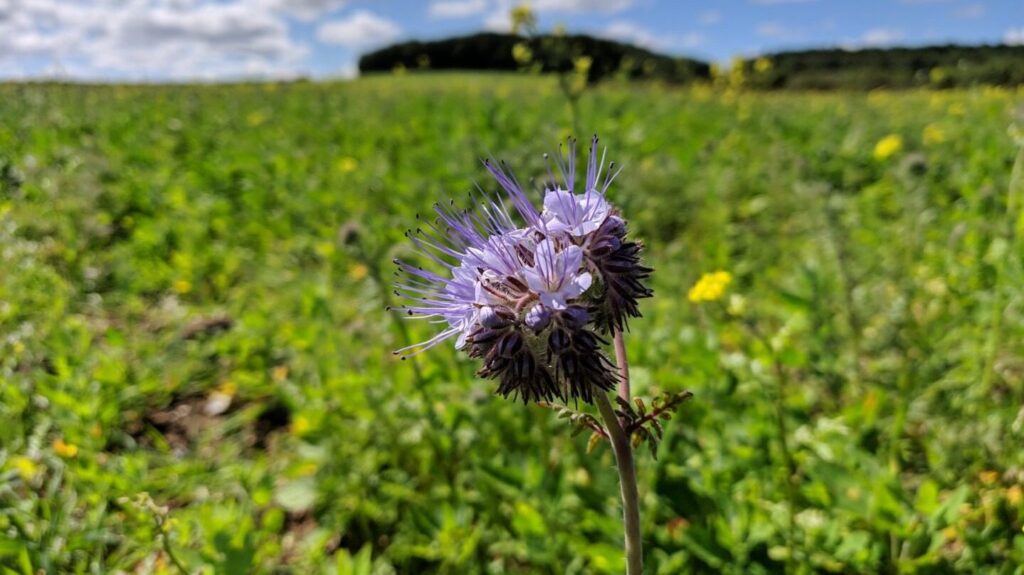
Cover crops are non-cash crops grown between two other crops. Their primary purpose is to shield and enrich the soil.
That’s all we really knew to begin with.
What we were less sure of was:
- What needed to go in them – a single species or several?
- What did each species in a cover crop do? What could help us reduce flood and erosion risk, stimulate soil biology and put organic matter back into the soil?
- How would we plant the crop? Broadcast or drill?
- What did we do with them when we didn’t need them any more?
Plenty of guidance is available online, including NIAB TAG and Kellogg’s free guide to cover crops and Cotswold Seeds and Garden Organic’s ‘Sort Out Your Soil’, both available through Agricology.
There are masses of events and webinars talking about soil health and regenerative agriculture, of which cover cropping is a core component. Last March, shortly before the first lockdown, I went to the Innovation for Agriculture Animals to Arable Conference, which looked at introducing animals into arable rotations to improve soil quality. It was a really worthwhile day not least for great presentations on cover crops, herbal leys and soil health from Ian Wilkinson at Cotswold Seeds and Stephen Briggs at Abacus Agriculture.
I called Cotswold Seeds and spoke with their technical manager, Sam Lane. Cotswold Seeds, like many other seed companies, sell ready-to-go cover crop mixes, but they can also advise on bespoke mixes. I described our situation to Sam and what we needed:
Mitigate against runoff and erosion
Several of our fields are susceptible to erosion, due to changing climate, soil type and the topography of our farm, but most of all due to a deterioration in soil quality over time, growing root crops and leaving soil bare. We need to shield the soil with green cover and bind the soil with living roots to reduce the risk of further erosion by water and wind.

Flood damage caused to a wheat field after winter storms 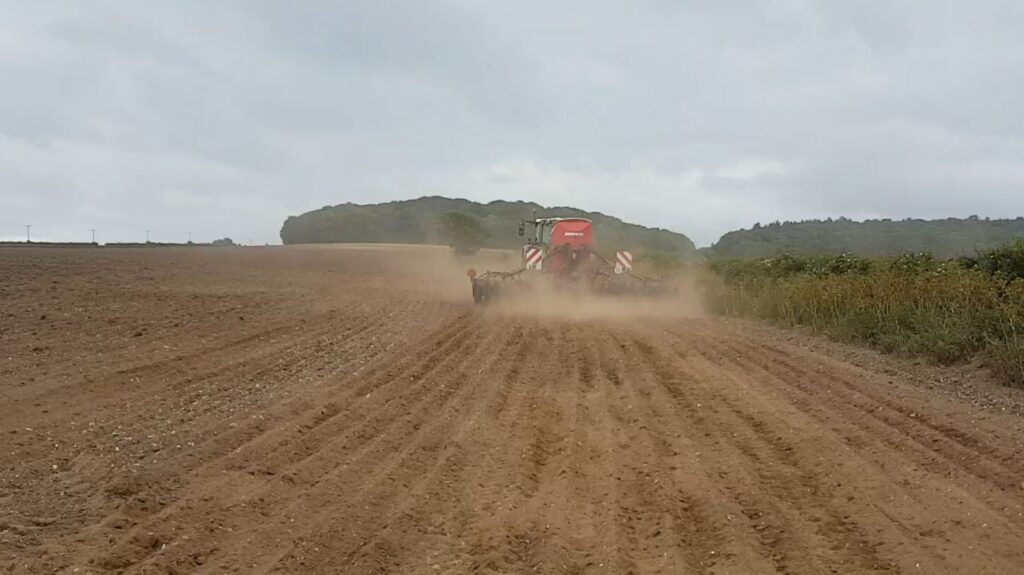
Dust following a crop drill
Cover crops provide protection against erosion by the physical action of wind and rain, but living roots also support the stability of soil aggregates through the presence of mycorrhizal fungi and their production of exudates like glomalin, a sticky substance that glues soil together forming stable structures that allow water to infiltrate.
Build organic matter and fertility
For a long time, the farm has relied on artificial inputs of nitrogen and other supplements. Before we started organic conversion, we, like most other conventional farms, had an agronomist – an expert in soil management and crop production. He worked for an agrochemical company. His advice was free because we paid for the chemicals he sold us. A ‘rec’ or recommendation for something a crop needed would invariably be for a chemical.
Even our agronomist was telling us we needed more organic matter in our soil. Having had our soil tested recently, we know that most of it contains 2-2.9% organic matter. Healthy soil should contain 5% or more – for our sandy loam soil with lower capacity to hold organic matter, 2% is not disastrous, but it could be significantly improved. You can tell just by looking at our soils and crumbling them in your hands. Soil organic matter stores nutrients to feed crops and other plants, supports soil biology in cycling those nutrients, and builds structure.
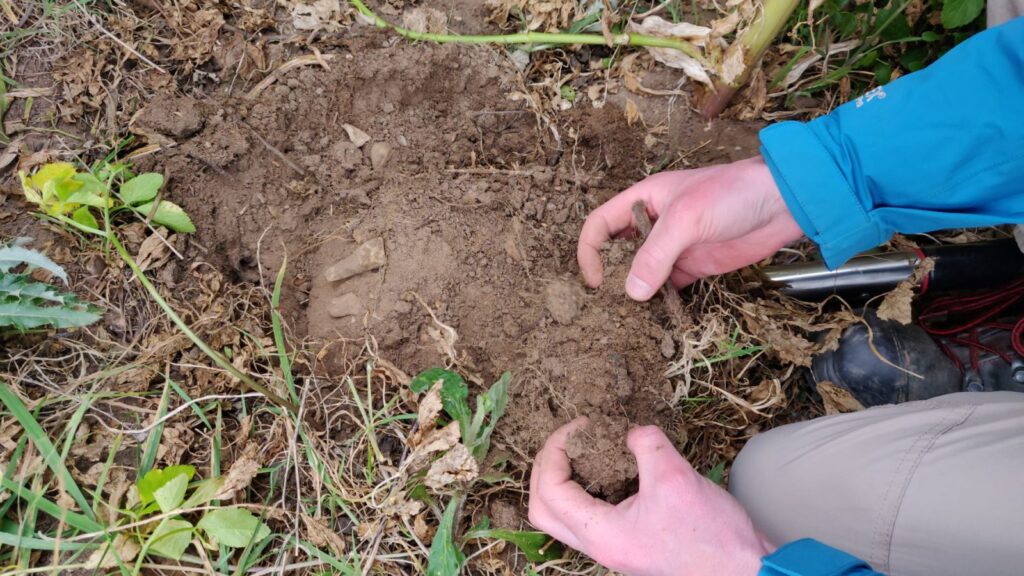
Now that we have entered organic conversion across the whole farm, we no longer have chemical inputs to fall back on, so a cover crop is one of the ways that we can boost soil fertility, by using nitrogen-fixing legumes and brassicas that build organic matter.
In that cover crops are also grown to suppress weeds, we also have a biological alternative to herbicides.
Aid soil recovery after carrot growing
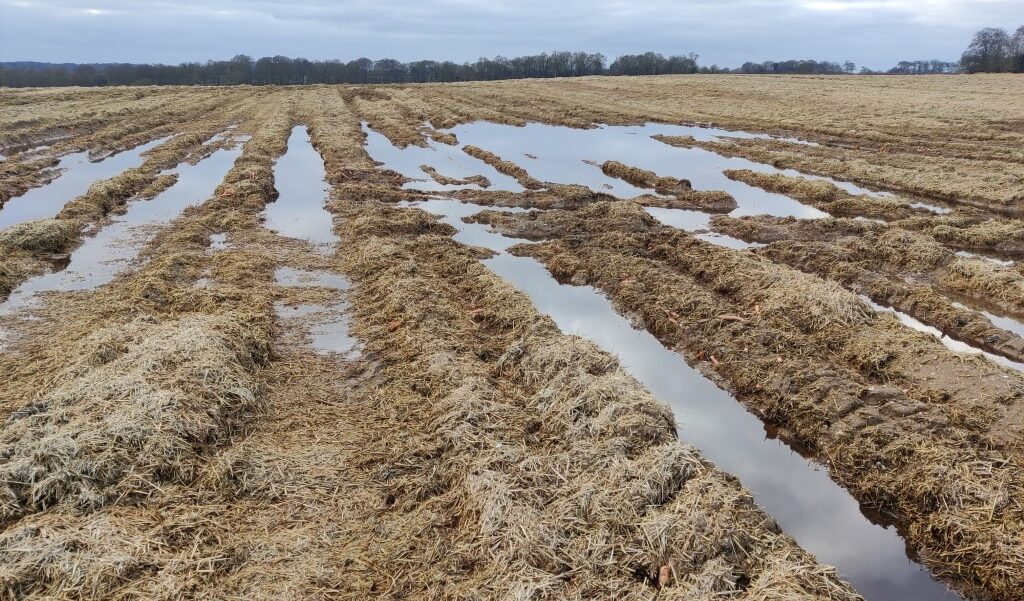
The fields we’re putting cover crops onto have been used to grow carrots – the carrots were covered in up to two feet of straw over winter which was then incorporated into the soil by cultivation after the carrots were harvested. That straw, several tonnes across the field, needs to break down so we need to stimulate the soil biology to support that process by providing additional nitrogen. We want to fix and store nitrogen with our cover crops already, but this is an additional requirement to power the breakdown of all that straw. If the straw doesn’t rot it simply sits there underground, and could even compete with the following crop for nitrogen as the soil biology needs it to break the straw down.
The deep taproots of some plants may also penetrate compacted soil in carrot beds, minimising our reliance on relieving compaction by mechanical means as well as improving drainage.
The ‘soil TLC’ cover crop
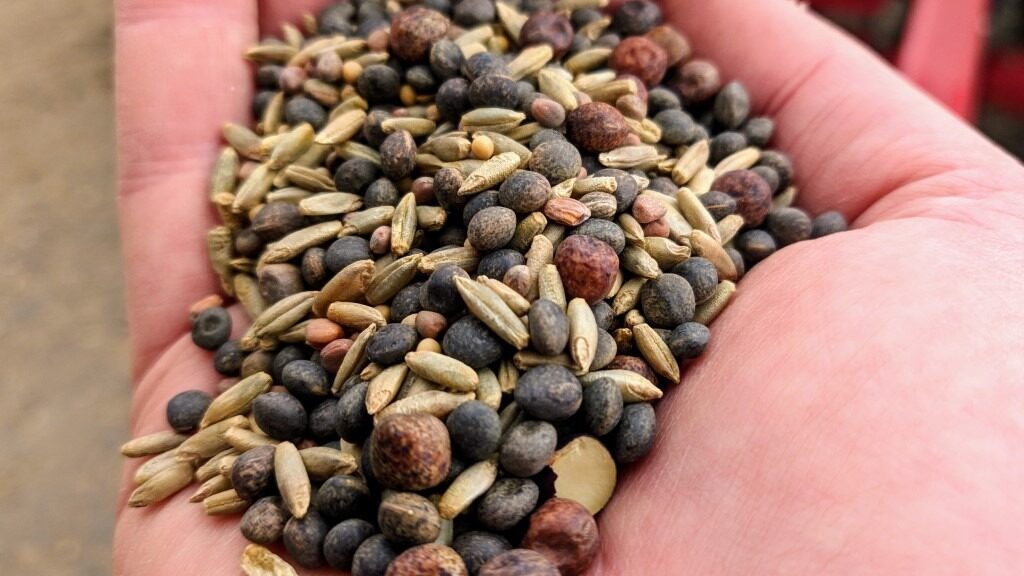
Sam suggested this mix, a diverse nine species cover crop. We quickly realised that broadcasting wasn’t going to work – larger seeds like vetch and pea and smaller seeds like mustard would end up landing in different places and give uneven coverage. We opted to shallow drill.
| Species/variety | Weight (kg/ha) |
|---|---|
| Brassicas | |
| Tilney mustard | 1.5 |
| Ikarus fodder radish | 1.25 |
| Structurator tillage radish | 0.32 |
| Legumes | |
| Early English vetch | 10.325 |
| Heusers Ostsaat crimson clover | 0.3 |
| Vittoria persian clover | 0.105 |
| Livioletta forage pea | 3 |
| Others | |
| Anabela phacelia | 0.375 |
| Dankowskie diamente rye | 10.325 |
| Total | 27.5 |
Brassicas
Competitive and quick-growing, these plants quickly provide soil cover and shielding, building organic matter. Mustard builds a strong rooting system while radishes build a deep taproot that penetrates the soil as well as sequestering nitrogen from the legumes in the mix, preventing it from leaching away.
Legumes
The legumes fix nitrogen in the soil, improve soil structure and produce biomass – particularly the vetch and pea. Less competitive against weeds or other growth than the brassicas, the legumes in our cover crops really thrived after we topped the cover crop in August.
Others
The phacelia is fast to establish, competitive, with fibrous roots and flowers that provide a great source of nectar for wildlife. Phacelia works as a soil conditioner and weed suppressant and holds nitrogen, preventing leaching like the brassicas.
The rye roots at shallow depths opening up the surface soil structure and gives good ground cover. We noticed how the roots of the rye plants held together a large ball of dark, healthy looking soil.
Cover crop timeline
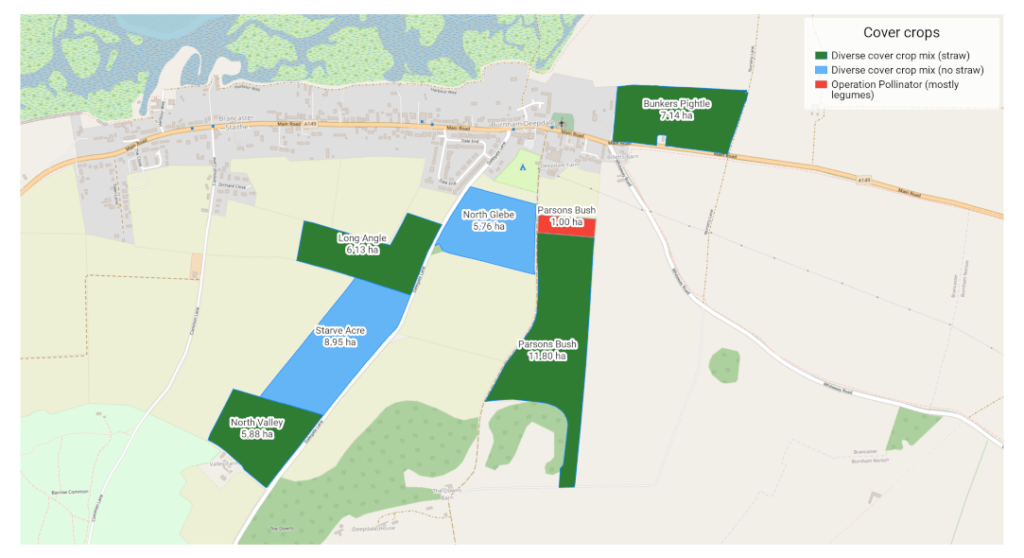
Early March 2020 – carrots are lifted after winter, fields ploughed and harrowed to incorporate straw.
2-3 June 2020 – fields are spread with biomass (digested sewage cake) at 10t/ha. This was intended to provide a readily available source of N to kick off breakdown of the straw that had been incorporated – to start the work of the cover crop. This was spread much later than we would have liked by around two months due to delays with Anglian Water, suppliers of the biomass.
12 June 2020 – cover crop shallow drilled into soil which had been disced following addition of biomass.
15 June 2020 – Nitram spread on cover crop at 100kg/ha. This top dressing was intended to support the cover crop in getting established quickly.
After this final application of Nitram, all fields entered organic conversion and we applied for a major new mid-tier Countryside Stewardship agreement which put most of the farm into environmental features such as pollinator margins, while 100 hectares was to be cropped in twenty separate five-hectare plots. We opted to leave the cover crops in place over winter on fields that were not going to be cropped and around cropped margins, to provide ongoing soil shielding.
16 August 2020 – Cover crops topped to 8 inches to prevent radish, phacelia and mustard running to seed while avoiding legumes and allowing them to grow on.
5 October 2020 – Cover crop in two five-hectare plots is topped, as close to the ground as possible this time. We break two tractor rear windows throwing up stones in the process.
31 October 2020 – Organic poultry litter spread on cropped plots. This and the remains of the cover crop were incorporated with disc harrow.
10 November 2020 – Winter wheat drilled in two five-hectare plots.
April 2021 (time of writing) – overwintered cover crops still in place, radishes killed by snow/frost.
How our cover crops performed

Now that last year’s cover crops have either been cut and incorporated or killed by winter frosts, we can start to look back at how effectively they delivered the benefits we were looking for.
How the cover crops prevented runoff and erosion
The main job of our first cover crops was soil shielding and preventing erosion – and they performed brilliantly.
We had heavy rain again this last winter – probably our wettest winter on record. Our fields were in a range of conditions:
- bare after potatoes and carrots were harvested with no time to sow cover crops (one field was harvested for carrots in January even as heavy rain was falling)
- in winter wheat
- in wheat stubble
- under cover crops
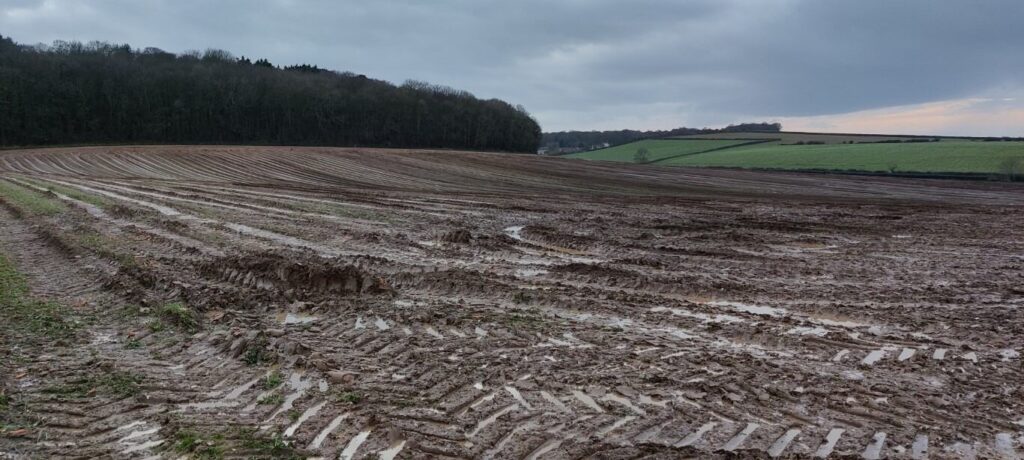
Bare soil after carrot harvest 
Runoff down compacted wheelings in wheat stubble 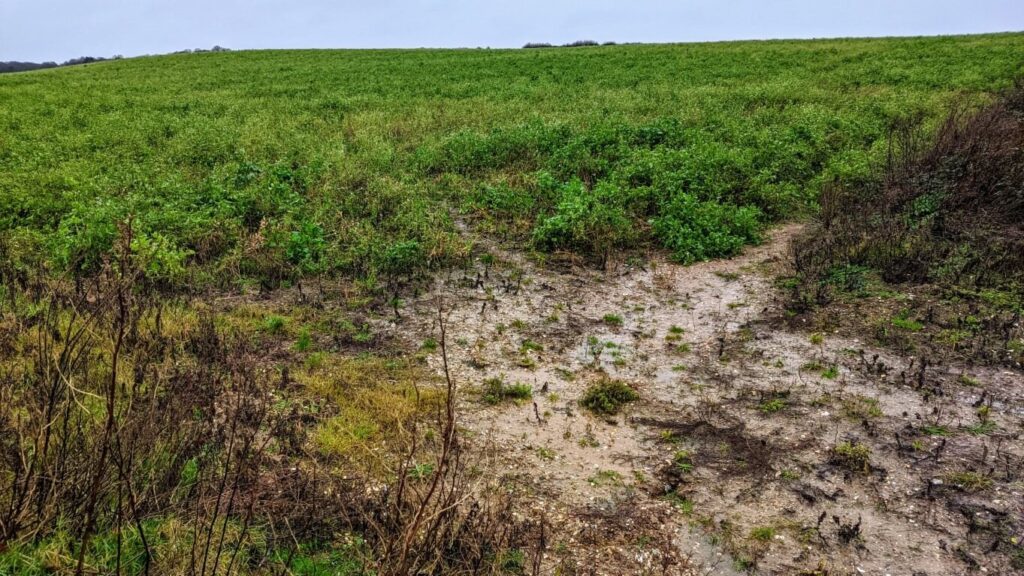
Field with overwintered cover crop
Fields that were bare were badly damaged, as we expected. Even after cultivation to alleviate compaction, we saw gouging and soil loss. The fields with winter wheat were damaged by heavy rainfall with some areas standing wet for over a month. Fields in wheat stubble fared better but we still saw runoff and erosion down wheelings, despite having cultivated wheelings to try and minimise this. The fields we had under cover crops had hardly any runoff and no erosion, including on sloping fields that had previously suffered the worst from heavy rainfall.
Fields under cover crops also showed no sign of wind erosion. A sight we’ve become accustomed to if cultivating or just travelling on bare, dry fields was clouds of windblown soil. We haven’t seen anything like this from fields under cover crops.
How the cover crops boosted organic matter and soil fertility
Before drilling our cover crops we added biomass, then after drilling, we added nitrogen to aid establishment. The cover crops fixed their own nitrogen as well as adding organic matter, and incorporated straw was also breaking down. Before drilling winter wheat we spread organic poultry litter. Trying to work out what contribution the cover crops have made to soil fertility and organic matter levels at this point is a bit like trying to unbake a cake, but we can make some observations:
- We saw that brassicas such as the radishes added organic matter to the soil in the form of thick, deep taproots and lush foliage. We saw fat radishes rotting in the fields after the cold snap in January.
- Where we dug up cover crop plants we saw darker soil, bound together by living roots.
- We have seen loads of white root nodules on legumes such as the vetch carrying fixed atmospheric nitrogen.
- Cover crops produced a thick, lush carpet of foliage.

A radish killed off by frost rots down adding organic matter to the soil 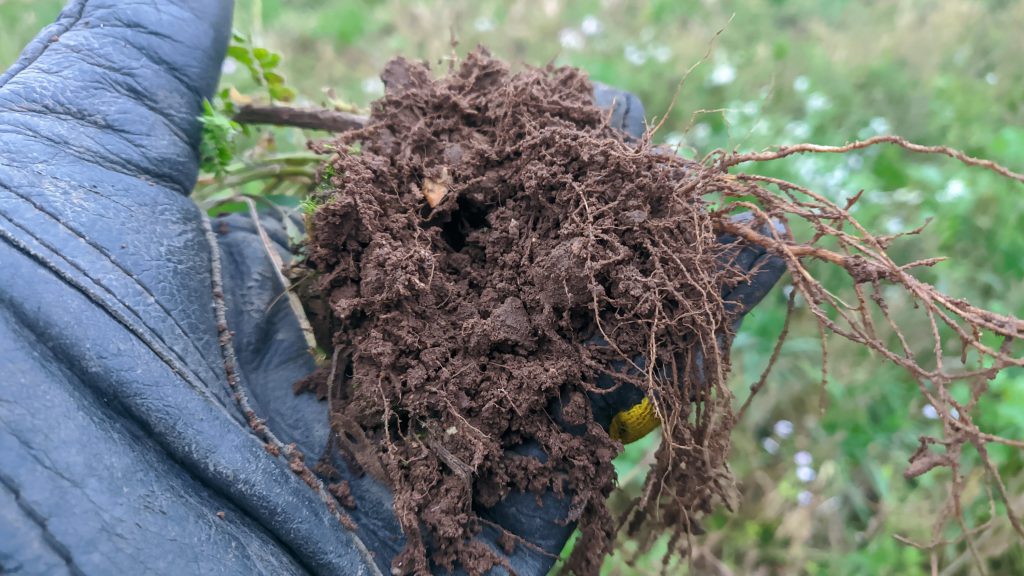
Soil, darker in colour and bound together by living roots 
Legumes, brassicas and grasses in a cover crop
In areas we were drilling wheat, we cut and mulched cover crops before incorporating the residue by disc harrowing. In other areas, we topped cover crops and left the residue to decompose on the soil surface, and left the crops over winter. Recent soil testing suggests that cover cropping may have had an effect on soil organic matter levels.

Starve Acre, Bunkers Pightle and Parsons Bush had all been under cover crops for around ten months, and have around 3% SOM. Burnham Brisk, Big Breck, Marsh Breck, Billetts Barn and Glebe did not have cover crops – their SOM content is lower. Lower Wood and Broad Marsh are exceptions – Lower Wood had been in carrots over winter and other than crop residue and carrots having been cultivated in, no additional organic matter was added and the field had not even been under straw. Broad Marsh has 5% SOM due to its silt clay loam composition which would better retain organic matter, as well as having been fallow for over a year.
We can’t read too much into these results. We know that organic matter such as animal droppings can make its way into samples despite our best efforts to check, and organic matter levels may have been affected by the crop growing in Bunkers Pightle and Parsons Bush or by other additions such as layer manure. This is likely only a short term improvement, and we need to repeat annual cover cropping and addition of organic matter over several years to see substantial improvements to soil organic matter levels, as well as re-testing. We also just need to trust our eyes and keep digging down and looking at soil structure and texture, earthworm signs and other indicators.
How cover crops helped the soil recover after carrot growing
Carrot fields were previously left fallow after harvest until drilling with wheat, with no input of organic matter. We would see clumps of ‘undigested’ straw appearing on the surface of the soil after cultivating for wheat – it hadn’t broken down, just sat buried during the fallow period. Before organic conversion, we added nitrate fertilizer to wheat crops, ironic when buried straw from the previous carrot crop was sequestering a free source of nitrogen away.
It has now been ten months since we drilled our first cover crops on the farm. In areas we drilled winter wheat, we cut cover crops and incorporated them by cultivating with a disc harrow after four months. We didn’t see any straw when we cultivated this time. The cover crop appears to have done the job of supporting the soil biology to break down the straw. If we dig down we can see well-rotted straw.
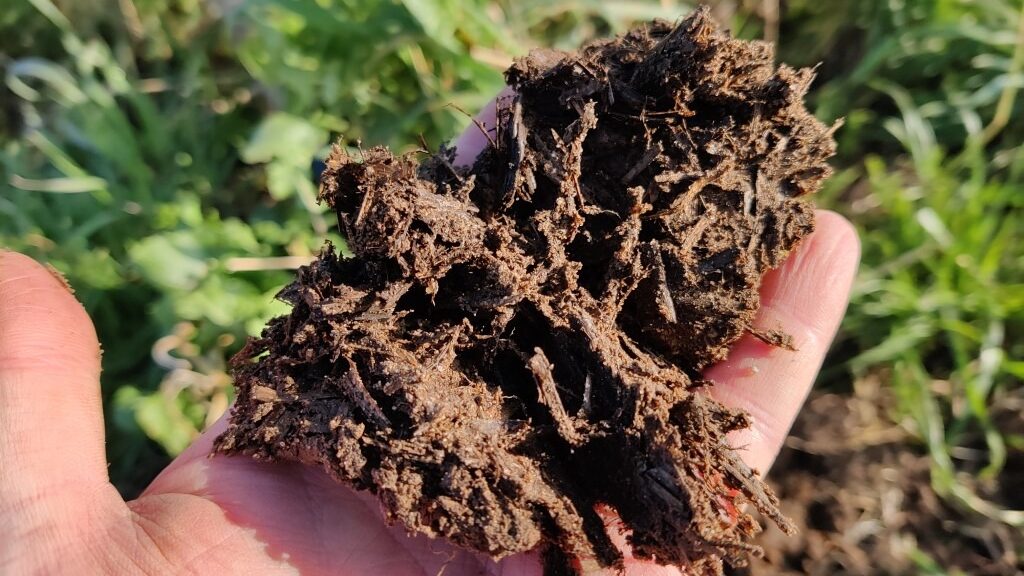
What we’ve learned so far
We’re still learning about cover crops – and we’ll continue to do so. We’re going to use them every year as part of our rotation. While it’s difficult to quantify the contribution they’ve made to soil organic matter levels or fertility so far, the soil shielding effect they have had on our easily eroded sandy loam soils is undeniable and was demonstrated vividly through another very wet winter.
I’ve tried to summarise some of what we have learnt so far below.
Any crop can be a cover crop
In years one and two of our cropping rotation we are using a mix of red clover, black medick, mustard, lucerne and late-flowering perennial ryegrass. This is essentially a cover crop, even if we choose to call it a clover ley. The point is that it is building fertility, supporting soil biology and shielding the soil from erosion. So do cover crops, and cash crops. So do environmental mixes such as pollinator mixes and wild bird seed mixes. Even arable plants do, to a lesser extent. We’re growing all of these crops and mixes – the point is that they’re in the ground, growing, churning out root exudates, shielding the soil, supporting soil biology. What we don’t want is nothing.
Cover crops keep a healthy balance
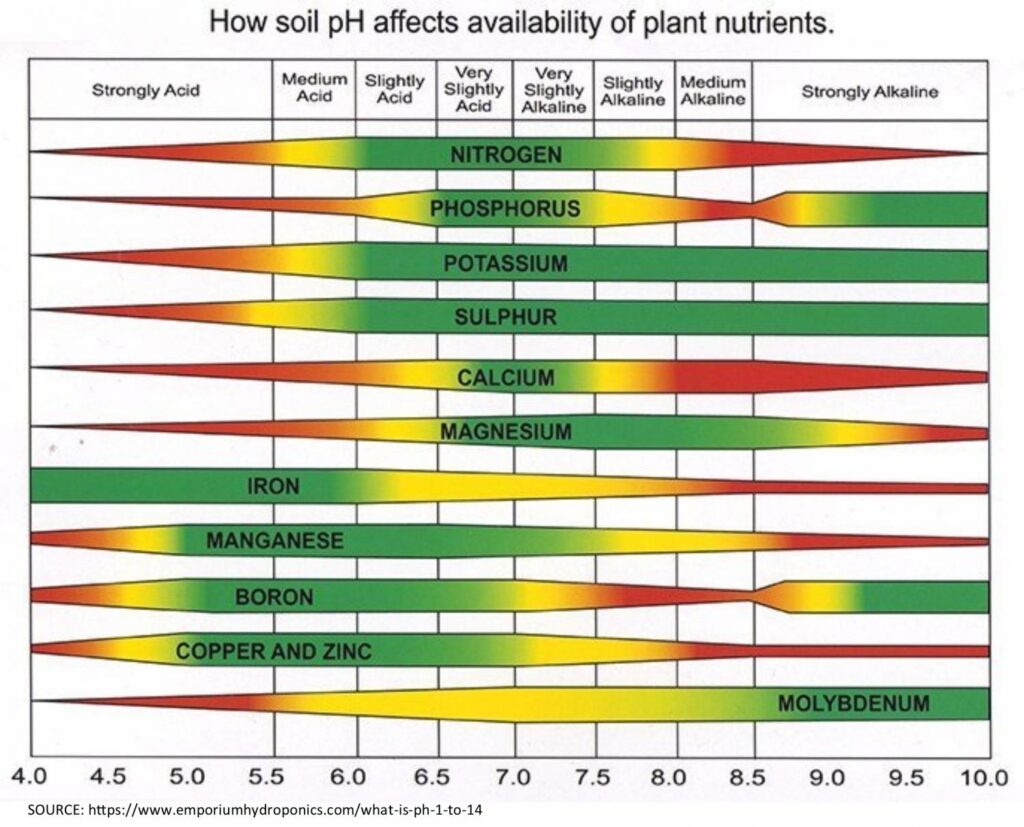
There are still further reasons to keep living roots in the ground. Our chalky soils are alkaline, with a pH ranging from 7.3-8.3. Most plants prefer slightly more acidic conditions, around pH 6.5, to absorb a wider range of nutrients more easily.
Keeping living roots in the soil and increasing organic matter levels appears to lower pH levels and improve the buffering capacity of the soil, stabilising pH.
Pick and mix
With a specific set of requirements, we chose a mix targeted to addressing them, getting sound technical advice. It’s really worth working out what if any particular jobs a cover crop has to do before selecting a mix, and talking to the seed company.
Embrace diversity
We used some straight mustard cover crops on the farm over winter for soil shielding but we saw far better longevity and performance from a diverse mix with brassicas, legumes and grasses and would definitely try and get at least a few varieties in future mixes (diversity of species is one of the core principles of a regenerative approach to farming, to support soil biodiversity). Diverse plants mean diversity of foliage, flowers, roots, nutrients and functions.
Going organic helps us to do this; we can’t use multi-species seed mixes unless 70% of the mix is organic, so one type of plant such as a red clover may be comprised of two varieties, one organic and one non-organic.
Work with others who’ve worked with cover crops
We’ve built up a good working relationship with Jack, a local contractor who has experience of cover crops – he gets it. It saved us a lot of hassle particularly at the start when we had no experience with them, and he gave us some good advice, including…
Cut / terminate at the right time
Cut some species too late and your crop residue may include tough, woody stems that take longer to break down or are more difficult to incorporate, so Jack advised us to cut cover crops while they were still green.
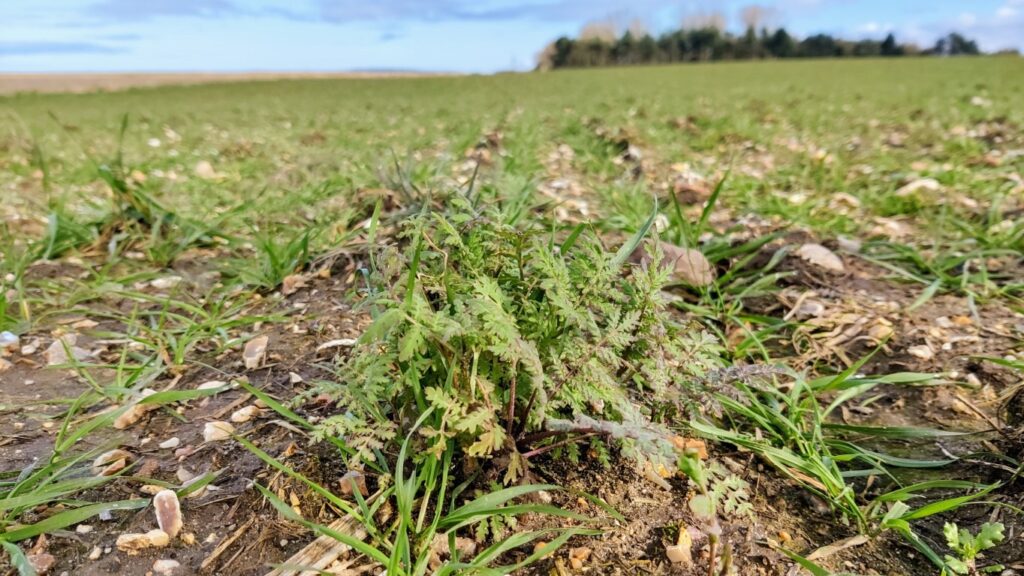
We also need to remember to terminate cover crops before they come back to haunt us. Phacelia, mustard and radish are all quick to set seed. We topped our cover crops in August after they had been in for two months, cutting to around eight inches above the ground, to prevent the brassicas and phacelia from setting seed. We were too late with a lot of the phacelia, which had gone over quickly and produces lots and lots of small seeds. We love phacelia, and so do the bees, which is a good job because it is now growing happily amongst our winter wheat.
….top for a second flush of growth
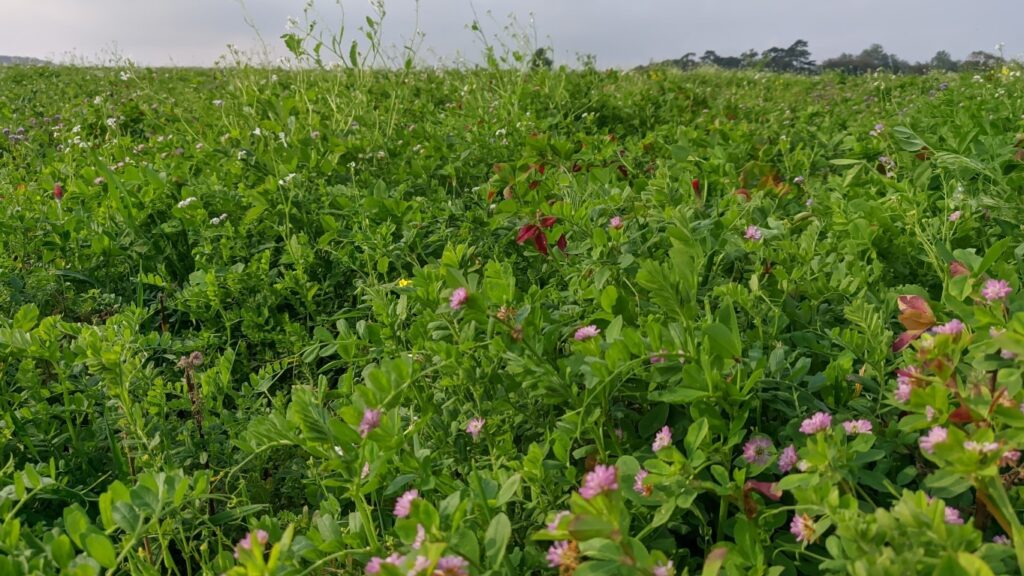
Topping the brassicas and grasses to eight inches after two months removed the competition from the vetch, peas and clover that were lurking in the understorey. They went ballistic. It was brilliant. Legumes fix the most nitrogen when it’s warm so we had a late summer of fertility-building, bee-buzzing goodness.
Happy wildlife and people
One thing we haven’t mentioned – wildlife loved our cover crops, and it’s one of the main reasons we’re so excited to grow them again in the future. We saw clouds of butterflies and legions of bees and other invertebrates over our cover crops, enjoying nectar-rich phacelia and the clover and other flowers. Visiting swallows spent days skitting over the tops of the crops, hoovering up insects. The farm looked stunning.
What’s even more exciting is that in the coming year, we’ll be growing a mix of cover crops and conservation crops providing value for pollinators, invertebrates, birds and other wildlife covering the entire farm at various times of the year. We’ve only just got started.
Thanks
Huge thanks to the Water Sensitive Farming team at Norfolk Rivers Trust for their advice and support. They set us on the road to a huge change at Deepdale Farm, and cover crops were the starting point.
Many thanks also to Sam and Lizzie at Cotswold Seeds for advice on our cover crop mix and for answering many daft questions since.
1 thought on “What we’re learning about cover crops”
Comments are closed.


[…] what we’re doing, we’ll share more on our experiences. The next update will focus on our experience so far with cover crops, and the role they have to play in protecting and improving the […]